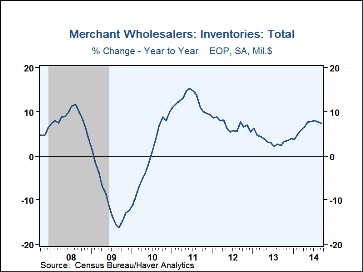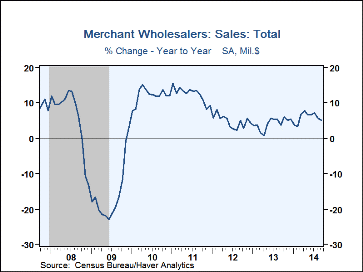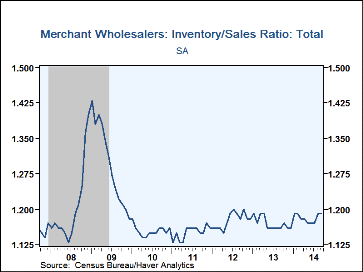 Global| Nov 12 2014
Global| Nov 12 2014U.S. Wholesale Inventory Growth Outpaces Sales
by:Tom Moeller
|in:Economy in Brief
Summary
Inventories in the wholesale sector increased 0.3% (7.4% y/y) during September following a 0.6% August rise, revised from 0.7%. Durable goods inventories rose a stable 0.8% (9.0% y/y), paced by a 3.4% jump (11.1% y/y) in computers & [...]
 Inventories in the wholesale sector increased 0.3% (7.4% y/y) during
September following a 0.6% August rise, revised from 0.7%. Durable goods inventories
rose a stable 0.8% (9.0% y/y), paced by a 3.4% jump (11.1% y/y) in computers & software.
Furniture & home furnishings inventories gained 1.5% (5.2% y/y) and motor vehicles
inventories increased 1.2% (13.4% y/y). Machinery inventories gained 0.5% (10.5% y/y) but
electrical equipment inventories fell 0.7% (+5.5% y/y). The 0.6% decline (+4.9%
y/y) in soft goods inventories was prompted by a 5.3% drop (-13.2% y/y) in
petroleum inventories. Nondurable goods inventories excluding oil slipped 0.1%
(+7.3% y/y). A 3.0% decline (-1.5% y/y) in farm products raw materials was
offset by a 2.4% increase (4.3% y/y) in chemicals and a 1.2% rise (11.2% y/y) in
apparel inventories.
Inventories in the wholesale sector increased 0.3% (7.4% y/y) during
September following a 0.6% August rise, revised from 0.7%. Durable goods inventories
rose a stable 0.8% (9.0% y/y), paced by a 3.4% jump (11.1% y/y) in computers & software.
Furniture & home furnishings inventories gained 1.5% (5.2% y/y) and motor vehicles
inventories increased 1.2% (13.4% y/y). Machinery inventories gained 0.5% (10.5% y/y) but
electrical equipment inventories fell 0.7% (+5.5% y/y). The 0.6% decline (+4.9%
y/y) in soft goods inventories was prompted by a 5.3% drop (-13.2% y/y) in
petroleum inventories. Nondurable goods inventories excluding oil slipped 0.1%
(+7.3% y/y). A 3.0% decline (-1.5% y/y) in farm products raw materials was
offset by a 2.4% increase (4.3% y/y) in chemicals and a 1.2% rise (11.2% y/y) in
apparel inventories.
Sales at the wholesale level improved 0.2% (5.2% y/y) after a 0.8% drop. Durables goods sales rose 0.5% (5.4% y/y), led by a steady 1.8% rise (4.8% y/y) in furniture sales. Automotive sales rebounded 1.4% (1.7% y/y) but computer & software sales slipped 0.1% (+2.7% y/y). Shipments of machinery declined 0.7% (+10.7% y/y). Nondurable goods sales slipped 0.1% (+5.1% y/y). Lower prices dragged petroleum sales down 1.7% (+1.3% y/y). Sales excluding petroleum rose 0.5% (6.5% y/y). That gain reflected a 4.0% jump (15.2% y/y) in apparel and a 1.0% rise (6.9% y/y) in groceries. To the downside, chemical sales fell 2.2% (+3.1% y/y).
The inventory to sales ratio was stable at 1.19, the highest level since February. The I/S ratio for durable goods wholesalers rose to 1.59, the highest point in six months. The ratio in motor vehicles slipped to 1.58 but for computer equipment it jumped to 0.87. In the nondurable goods area, the comparatively lower I/S ratio of 0.84 represented a 0.31 ratio in petroleum and 0.64 for groceries. In apparel industries, the ratio fell to 1.89 and in chemicals it was 1.16.
The wholesale trade figures are available in Haver's USECON database.
| Wholesale Sector - NAICS Classification (%) | Sep | Aug | Jul | Y/Y | 2013 | 2012 | 2011 |
|---|---|---|---|---|---|---|---|
| Inventories | 0.3 | 0.6 | 0.3 | 7.4 | 4.0 | 5.5 | 9.4 |
| Sales | 0.2 | -0.8 | 0.4 | 5.2 | 4.2 | 4.8 | 12.4 |
| I/S Ratio | 1.19 | 1.19 | 1.17 | 1.16 (Sep.'13) | 1.17 | 1.18 | 1.15 |
Tom Moeller
AuthorMore in Author Profile »Prior to joining Haver Analytics in 2000, Mr. Moeller worked as the Economist at Chancellor Capital Management from 1985 to 1999. There, he developed comprehensive economic forecasts and interpreted economic data for equity and fixed income portfolio managers. Also at Chancellor, Mr. Moeller worked as an equity analyst and was responsible for researching and rating companies in the economically sensitive automobile and housing industries for investment in Chancellor’s equity portfolio. Prior to joining Chancellor, Mr. Moeller was an Economist at Citibank from 1979 to 1984. He also analyzed pricing behavior in the metals industry for the Council on Wage and Price Stability in Washington, D.C. In 1999, Mr. Moeller received the award for most accurate forecast from the Forecasters' Club of New York. From 1990 to 1992 he was President of the New York Association for Business Economists. Mr. Moeller earned an M.B.A. in Finance from Fordham University, where he graduated in 1987. He holds a Bachelor of Arts in Economics from George Washington University.








